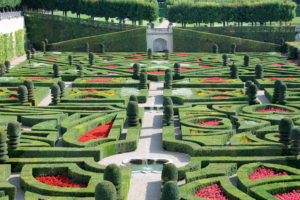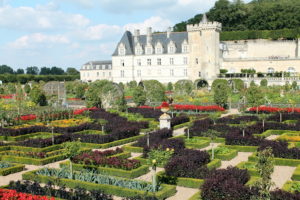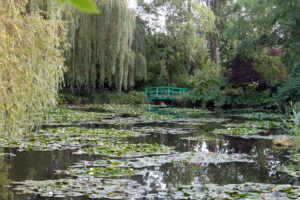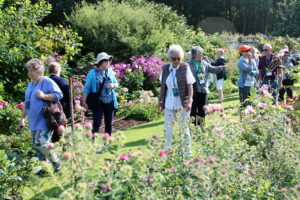Plants Like Ours
October 4th, 2016
Although it’s six time zones and an 8-hour flight across the Atlantic away, France has remarkably similar plants to our own.

French plants are a lot like ours… except we don’t do grand parterre gardens like this one at Chateau de Villandry.
I’m just back from leading an 8-day trip to great gardens in and around Paris, and of all the foreign countries I’ve been to (not counting Canada and Texas), this one was the most familiar plantwise.
The countryside looked identical to roadside I-283 – right down to fields of drought-stunted corn and a nuclear power plant with one tower spewing steam and one not.
No doubt the similar climate has a lot to do with the plant similarity. We both have four distinct seasons, erratic rainfall, and snow in winter, although Paris is slightly milder in winter.
If you just want to see some of the impressive gardens and sights we saw, check out the Paris 2016 Photo Gallery I just posted.
If you’re curious about what caught my eye, read on…
Maybe most people go to Paris for the food or the historic European atmosphere or to see the Eiffel Tower or the Louvre, but for me, the main attraction was the gardens.
My favorite of the seven we saw was the Chateau de Villandry, a privately owned palace along the Loire River with acres of formal gardens laid out in classic French style.
That means patterned beds of assorted geometric shapes (“parterres”), edged with low, neatly clipped boxwoods and yews and filled with different plants – usually one mass of one plant type per bed.
When you view it from above – which Villandry makes possible from the chateau as well as from an elevated viewing platform (belvedere) – the look is as “wow” as you’ll see anywhere in gardening. Of course, that’s the point if you’re trying to flaunt your wealth and prestige.
The section behind the chateau is like an embroidered painting of living flowers (“broderie”), apparently telling a story of four kinds of love (at least that’s what the literature explained since I rarely figure out the meaning behind artworks).
Even more impressive is the bigger “side yard” acreage filled with edible plants.
These blocks of beds are patterned with masses of 40 kinds of ornamental edibles, such as red-leafed beets, purple cabbage, assorted kales, black-fruited hot peppers, silvery cardoon, a variety of lettuces and greens, and vine-covered tunnels dripping with ripe grapes.
No wonder Villandry is known as “the world’s most famous vegetable garden.” I’d also call it the most impressive edible garden I’ve ever seen.
Here’s the curious twist – these gardens were restored by a woman from Lebanon, Pa. That would be Ann Coleman, whose family made a fortune from the Cornwall Furnace and other 19th-century iron works.
Coleman married a French physician named Joachim Carvallo after studying biology in Paris. The couple bought the abandoned, decaying chateau in 1906.
They restored both the chateau and its once-glorious gardens to their original Renaissance form, opening it to the public in 1920. It’s still owned and operated the Carvallo family.
The palace at Versailles also has impressive parterre gardens and a ton of statues, fountains and formal gardens, but my second favorite garden was painter Claude Monet’s Giverny.
This more modest home in the countryside northwest of Paris is a landscape of two very different gardens, divided by a road.
On the opposite side of the road from the house is a pond the size of three basketball courts. It’s in a tree-laden, natural, Japanese-style setting and has the famous green bridge lined with wisteria that’s the scene of one of Monet’s most recognized impressionist paintings (“Bridge over a Pond of Water Lilies”).
The garden seems as if the scene hasn’t changed since Monet’s day – very serene and surrounded by flowers of assorted colors befitting an impressionist master.
The garden in front of the house is at least an acre of mixed wall-to-wall flowers, packed tightly and intermingling as Monet preferred, to give the effect that one writer called a “paint factory that’s exploded.”
Neither of these gardens is very French (more English and Japanese), and they’re both dead opposite from Villandry’s and Versailles’ formality.
The third garden I liked a lot is Plessis Sasnieres, a 4-acre, Loire-Valley home garden designed, planted and cared for by a plant-lover named Rosamee Henrion.
The sister-in-law of former French president Giscard, Madame Henrion is not an aristocrat who directs a staff from a pristine patio. She’s a down-and-dirty gardener who pulls weeds, constantly moves plants, and gets annoyed at nuisance pests (in her case, badgers) – just like us ordinary American soil jockeys.
She’s particularly attracted to specimen trees and shrubs, and her collection includes yellowwood, Persian parrotia and magnolia trees, mature cryptomerias, an elegant seven-son flower (Heptacodium) that was still in bloom in late September, and the most gorgeous ‘Blue Wave’ lacecap hydrangea I’ve ever seen. (We can grow all of those, by the way.)
Plessis also has arches of espaliered apple trees, classic English perennial border gardens, and a patch of gunnera (think spiny elephant ears on steroids) growing along a waterfall.
It’s pretty amazing for the work of one woman with just a few helpers and a lifelong passion most anything bearing chlorophyll.
Overall, I think most Americans lean toward a French-influenced style of gardening without really knowing it (albeit not the scale of Villandry or Versailles).
We generally like the color and looseness of English gardening, but we also like a bit of the organization of Italian gardens.
French gardening is a sort of hybrid of the two. Our twist is trying to make that as low-care as possible.










